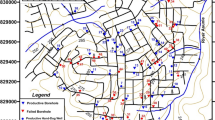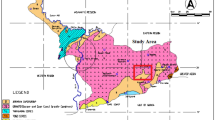Abstract
Availability of groundwater often constitutes a problem in basement terrain because of its erratic occurrence. Incessant failures of boreholes have been reported in Ekiti East Local Government Area (EELGA), Southwestern Nigeria warranting evaluating its groundwater potential using a multi-criteria model that involved geology, resistivity and thickness (GRT) model of the aquifers across the study area. Thirty-five (35) locations were occupied using vertical electrical sounding (VES) technique employing the Schlumberger electrode array. The VES data were interpreted quantitatively by partial curve matching and 1-D computer iteration to facilitate siting of appropriate boreholes locations. The geophysical survey revealed twelve (12) types of resistivity curve: KH (\(\rho 1<\rho 2>\rho 3<\rho 4)\), KQH (\(\rho 1<\rho 2>\rho 3>\rho 4<\rho 5)\), KQQ (\(\rho 1<\rho 2>\rho 3>\rho 4>\rho 5)\), QH (\(\rho 1>\rho 2>\rho 3<\rho 4)\), KQ (\(\rho 1<\rho 2>\rho 3>\rho 4)\), HKQ (\(\rho 1>\rho 2<\rho 3>\rho 4>\rho 5)\), AK (ρ1 < ρ2 < ρ3 > ρ4), HA (\(\rho 1>\rho 2<\rho 3<\rho 4)\), KHA (\(\rho 1<\rho 2>\rho 3<\rho 4<\rho 5)\), HAA (\(\rho 1>\rho 2<\rho 3<\rho 4<\rho 5)\), QHA (\(\rho 1>\rho 2>\rho 3<\rho 4<\rho 5)\) and HKH (\(\rho 1>\rho 2<\rho 3>\rho 4<\rho 5)\). The four-layer curve types observed within the area accounted for 57% of the curve types, while the five-layer types were 43%. The maps of aquifer layer resistivity and aquifer layer thickness were generated and synthesized with the geology of the study area in producing the GRT model groundwater potential map. The groundwater potential map revealed the northern part of the study area as an area with high groundwater potential, while the southern part was characterized as low groundwater potential terrain. EELGA is categorized into low, medium and high groundwater potential zones with the northern part more favorable for siting of boreholes. The groundwater potential map will serve as an exploration guide in addition to its usefulness in groundwater sustainability development.





Similar content being viewed by others
References
Ademilua, O. L., & Eluwole, A. B. (2013). Hydrogeophysical evaluation of the groundwater potential of Afe Babalola University Ado-Ekiti, Southwestern Nigeria. Journal of Emerging Trends in Engineering and Applied Sciences USA,4(1), 77–83.
Ademilua, O. L., Ojo, O. F., Eluwole, A. B., & Ademilua, O. B. (2014). Geophysical survey for groundwater resource appraissal in a basement complex terrain for agricultural purposes Case study of ABUAD teaching and research farm, Ado Ekiti, Southwest Nigeria. Global Journal of Science Frontier Research (USA),14(5 Version 1), 1–14.
Adeyemo, I. A., Omosuyi, G. O., Ojo, B. T., & Adekunle, A. (2017). Groundwater potential evaluation in a typical basement complex environment using GRT Index—a case study of Ipinsa-Okeodu Area, near Akure, Nigeria. Journal of Geoscience and Environment Protection,5, 240–251.
Akintorinwa, O. J., & Olowolafe, T. S. (2013). Geoelectric evaluation of groundwater prospect within Zion Estate, Akure, Southwest, Nigeria. International Journal of Water Resources and Environmental Engineering,5, 12–28.
Ashaolu, E. D., & Adebayo, M. O. (2014). Characterizing groundwater level and flow pattern in shallow overburden aquifer: a study of Ilara-Mokin and its environs, Southwestern. Nigeria. Momona Ethiopian Journal of Science,6(2), 55–74.
Ayenew, T., Demlie, M., & Wohnlich, S. (2008). Hydrogeological framework and occurrence of groundwater in the Ethiopian aquifers. Journal of African Earth Sciences.,52, 97–113. https://doi.org/10.1016/j.jafrearsci.2008.06.006.
Bala, A. E., & Ike, E. C. (2001). The aquifer of the crystalline basement rocks in Gusau area, northwestern Nigeria. Journal of Mining and Geology.,37(2), 177–184.
Bayewu, O. O., Oloruntola, M. O., Mosuro, G. O., Laniyan, T. A., Ariyo, S. O., & Fatoba, J. O. (2017). Geophysical evaluation of groundwater potential in part of southwestern basement complex terrain of Nigeria. Appl Water Sci.,7(8), 4615–4632. https://doi.org/10.1007/s13201-017-0623-4.
Bayowa, O. G., Olorunfemi, M. O., Akinluyi, F. O., & Ademilua, O. L. (2014). Integration of hydrogeophysical and remote sensing data in the assessment of groundwater potential of the basement complex terrain of Ekiti State, Southwestern Nigeria. Ife Journal of Science,16(3), 353–363.
Clark, L. (1985). Groundwater abstraction from basement complex area of Africa. Quarterly Journal of Engineering Geology and Hydrogeology,18, 25–34. https://doi.org/10.1144/GSL.QJEG.1985.018.01.05.
Dan-Hassan, M. A. (1993). Combined electromagnetic and electrical resistivity survey for groundwater development in North Central part of Kaduna State. Unpubli. M.Sc. Thesis, Geology Department, Obafemi Awolowo University, Ile-Ife, Nigeria. pp. 1–107.
Ekwe, A. C., Onu, M. N., & Onuoha, K. M. (2006). Estimation of aquifer hydraulic characteristics from electrical sounding data: the case of Middle Imo River Basin Aquifer South Eastern Nigeria. Journal of Spacial Hydrology.,6, 121–131.
Ifabiyi, I. P., Ashaolu, E. D., & Omotosho, O. (2016). Hydrogeological characteristics of groundwater yield in shallow wells of the regolith aquifer: a study from Ilorin, Nigeria. Momona Ethiopian Journal of Science (MEJS), V8(1):23–36. ©CNCS, Mekelle University, ISSN:2220-184X
Jellalia, D., Lachaal, F., Andoulsi, M., Zouaghi, T., Hamdi, M., & Bédir, M. (2015). Hydro-geophysical and geochemical investigation of shallow and deep neogene aquifer systems in Hajeb Layoun-Jilma-Ouled Asker area, Central Tunisia. Journal of African Earth Sciences.,110, 227–244. https://doi.org/10.1016/j.jafrearsci.2015.06.016.
Lewis, M. A. (1987). The analysis of borehole yields from basement aquifers. In Proceedings of the Basement Aquifer Workshop, 15–24 June, 1987, Zimbabwe. Commonwealth Science Council CSC (89) WMR 13, TP 273.
Mailu, G. (1987). Hydrogeology of the metamorphic region of the Athi drainage area. Kenya. In Proceedings of the basement aquifer workshops, 15–24 June, 1987, Zimbabwe. Commonwealth Science Council, CSC (89) WMR 13, TP, 273.
Mogaji, K. A., Omosuyi, G. O., & Olayanju, G. M. (2011). Groundwater system evaluation and protective capacity of overburden material at Ile-Oluji, Southwestern Nigeria. Journal of Geology and Mining Research,3, 294–304.
National Population Commision. (2006). 1963, 1991 and 2006 Cencus of each local government area of Ekiti State. Ado-Ekiti: National Population Commision, Ekiti State Chapter.
Nwankwo, L. I. (2011). 2D Resistivity survey for groundwater exploration in a hard rock terrain: a case study of Magdas observatory, University of Ilorin, Nigeria. Asian Journal Earth Science,4(1), 46–53.
Ogundana, A. K., & Talabi, A. O. (2014). Groundwater potential evaluation of College of Engineering, Afe Babalola University, Ado-Ekiti, Southwestern Nigeria. American Journal of Water Resources,2(1), 25–30. https://doi.org/10.12691/ajwr-2-1-4.
Olorunfemi, M. O., & Fasuyi, S. A. (1993). Aquifer types and the geoelectric/hydrogeologic characteristics of part of the central basement terrain of Nigeria (Niger State). Journal of African Earth Sciences,16(3), 309–317.
Olorunfemi, M. O., Ojo, J. S., & Akintunde, O. M. (1999). Hydro-geophysical evaluation of the groundwater potentials of the Akure Metropolis, Southestern Nigeria. Journal of Mining and Geology,35(2), 207–228.
Olorunniwo, M. A., & Olorunfemi, M. O. (1987). Geophysical investigations for groundwater in Precambrian Terrains: a case study from Ikare, Southwestern Nigeria. Journal of African Earth Sciences,6(6), 787–796.
Omosuyi, G. O., & Oseghale, A. (2012). Groundwater vulnerability assessment in shallow aquifers using geoelectric and hydrogeologic parameters at Odigbo, Southwestern Nigeria. Journal of Scientific and Industrial Research,3, 501–512.
Salau, O. R., Ewumi, T., Owolabi, B. E., Ajayi, G. O., & Ajayi, O. E. (2016). Regional distribution of malaria in Ekiti State, Nigeria. World Scientific News (WSN) 55, 89–100. EISSN 2392–2192
Shemang, E. M. (1990). Electrical depth soundings at selected well sites within the Kubani River basin, Nigeria. Unpublished M.Sc. Thesis, A.B.U Zaria, Zaria. pp. 108.
Talabi, A. O. (2018). Estimated volume of water in shallow wells of Ekiti State, Southwestern Nigeria: implications on groundwater sustainability. Arabian Journal of Geosciences,11, 1–9. https://doi.org/10.1007/s12517-018-4031-3.
Talabi, A. O., & Tijani, M. N. (2011). Integrated remote sensing and GIS approach to groundwater potential assessment in the basement terrain of Ekiti area southwestern Nigeria. RMZ—Materials and Geoenvironment 58(3), 303–328.
Vander-Velpen, B. P. A. (2004). Win RESIST Version 1.0. M. Sc Research Project. ITC, Deft, Netherlands.
Acknowledgments
The authors wish to thank all who assisted in conducting this work.
Funding
This research did not receive any specific grant from funding agencies in the public, commercial, or not-for-profit sectors.
Author information
Authors and Affiliations
Corresponding author
Ethics declarations
Conflict of interest
The authors declare that they have no conflict of interest.
Rights and permissions
About this article
Cite this article
Popoola, K., Talabi, A.O., Afolagboye, L.O. et al. Groundwater potential evaluation in the basement complex terrain of Ekiti East Local Government Area, Southwestern Nigeria. Int J Energ Water Res 4, 81–90 (2020). https://doi.org/10.1007/s42108-019-00053-5
Received:
Accepted:
Published:
Issue Date:
DOI: https://doi.org/10.1007/s42108-019-00053-5




